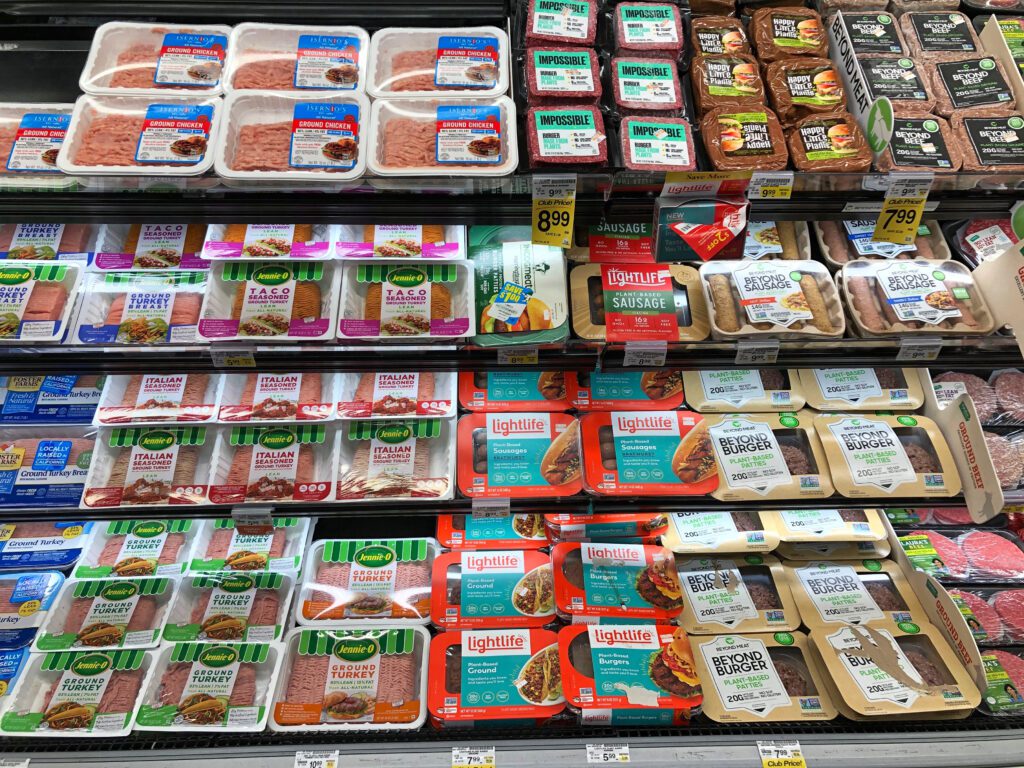
Brad Jakeman
Founding Managing Partner, Rethink Food
Plant-based meats – complex recipes of soy, oils, yeast, and potatoes that mimic the texture, appearance, and even “bleeding” of flesh – appeared to be unstoppable for a while. Beyond Meat’s stock shot up 163% on the day it went public in May 2019, marking the biggest one-day performance for a major American firm in almost two decades (1). The Los Angeles-based company, along with its fellow California neighbor Impossible Foods, had positioned itself at the forefront of a new protein market, giving the once niche world of meat substitutes a Silicon Valley halo. Between 2018 and 2021, sales of artificial meat increased by 74% due to clever marketing and sincere consumer concerns about the environmental effects of meat production (2). Analysts projected that the market for alternative meats would continue to grow if the hype cycle persisted. According to Barclays, the market would reach $140 billion by 2030 (3). The Boston Consulting Group made an even bolder prediction, estimating $290 billion by 2035 (4).
The origins of plant-based meat
Despite the rise in popularity in the past few years, alternative sources of “meat” are not new. In fact, they date back to the early 1900s when Kellogg controlled a food company that marketed Protose, a soy, peanut, and wheat gluten alternative for meat. Protose was discontinued by Kellogg in 2000 but the company is still credited with being well ahead of its time.
Protose, like Beyond and Impossible, is an example of a “second-generation” plant-based meat substitute, whereas tofu and tempeh are considered “first-generation.” While “first-generation” alternatives are high in protein, they don’t have much in common with traditional meat. Conversely, “second generation” alternatives are made to resemble meat in terms of appearance, texture, and flavor. The intention of the alternatives likeness to real meat was to appeal to omnivores and “flexitarians,” or those who eat meat but wish to reduce their intake for health or environmental reasons.
For example, Impossible created an ingredient called “Heme,” a genetically altered form of iron that allows its imitation meat to “bleed” to resemble meat from a pig or cow. Our portfolio company Motif FoodWorks followed with a less expensive ingredient called “Hemami,” which has similar effects. The two companies are currently in a legal dispute as Impossible Foods wants to claim ownership over the Heme ingredient, a protein found in nature. If Impossible claims ownership of the protein, it will hinder further innovation and collaboration in the category, in which many would argue is greatly needed.

So, what spiked the recent infatuation with these “second-generation” alternatives? Plant-based meat companies like Impossible, Beyond Meat, and Gardein saw a 45% increase in sales in 2020 as a result of the COVID-19 pandemic and at-home isolation, when many consumers experimented with new foods and recipes (5). Additionally, the rising concern on climate change signaled the beginning of a new era in plant-based meat eating, it appeared as if everyone would soon be consuming steaks, chicken fingers, and hamburgers made entirely out of veggies.
There is no denying the benefits that plant-based meat alternatives have on the environment. According to the Food and Agriculture Organization, livestock production accounts for 14.5% of greenhouse gas emissions worldwide, two-thirds of which come from cattle (6). In fact, producing 100 grams of protein from beef releases about 25 kg of greenhouse gasses into the environment, whereas producing the same quantity of tofu releases about 1.6 kg.7 Overall, plant-based meats produce 40–90% less greenhouse gas emissions than traditional meats (7).
But as the saying goes, every journey has its bumps, and plant-based meats encountered its first in 2021, when sales reached a plateau and began to decline. In the last 18 months, the price of Beyond Meat’s shares has dropped by about 80% (7) and Impossible laid off 6% of its employees in October 2022, one of two waves of layoffs that year (8). Thus, the plant-based meat category isn’t doing as well as anticipated, despite growing environmental concerns and the nearly 25% of Americans who say they have reduced their meat consumption (9).

What went wrong? Are plant-based meats dead?
In our view, plant-based proteins still have a lot of room to expand, even though consumer excitement for vegan meat substitutes does appear to be waning. The current wave of alternative meats sprang to popularity during a period of optimism driven by technology and venture capital spending. However, the food business is not the internet, and companies that produce plant-based meat are not internet startups. It’s evident that consumers, especially those outside of the U.S., are still willing to adopt more plant-based diets if given some encouragement from governments, even with the industry’s hype-boom-bust cycle.
At Rethink Food, we believe there are four interrelated factors driving the category’s lack luster performance:
1. “What’s in a name? That which we call a rose by any other name would smell as sweet.” -William Shakespere, Romeo and Juliet
Words have meaning but names have power and we would argue that “Plant-Based Meats” does not accomplish that for the category. This appears to be a classic case of marketing being left out of the process early. The scientists and entrepreneurs filled the void, and all of a sudden the category was named in a way that Marketing 101 students are taught never to do – naming the category after what it is, and not for the consumer benefit it provides.
The consequence is that if you’re a died-in-the-wool meat eater, something called “plant-based” is always going to feel less than. It’s no different than the “diet” soft drink trend of the 1980’s which now represents the steepest declining sub-category of soft drinks. “Plant-based” is not compelling to meat eaters because it intrinsically communicates that they are making a compromise, and with meat eaters representing 89% of the U.S. population, this is who the category desperately needs to convert to have any real environmental impact (10). Inversely, for vegans or vegetarians, while the “plant-based” prefix is music to their ears, the “meat” part isn’t, further illustrating the disconnect with the main target audience.
It may be too late, but we think the category needs a new lexicon, something like “Sustainable Proteins” that appeals to both audiences.
2. “The only time to eat diet food is while you’re waiting for the steak to cook.” -Julia Child
There’s a simple factor that all new foods must adhere to be successful – it must taste good. Consumers are prepared to compromise on many things (calories, cost, packaging) but taste is not one of them. The taste of existing plant-based meat products hasn’t quite developed to the point where consumers crave it. The Good Food Institute’s research demonstrates that when it comes to alternative meats, customers are most concerned about taste. Consumer studies show that 53% of consumers agree that plant-based meat products “should taste just like meat” (2).
This taste gap was widened by the industry’s desire to start with meat apologues like the burger, one of the most iconic and widely consumed menu items in American culture. Consumers have habituated to what the taste, texture, and appearance of a standard hamburger has been over decades. So, why did the industry choose a burger as the starting point? Why not create a new form factor to excite consumers and begin the journey to beefless meats?
Take for example the chicken nugget or the sandwich wrap. Someone once invented these form factors and consumers trialed them with little expectation of taste and experience because they had nothing to compare them to. It’s our view that a way to reignite the plant-based protein category is to move away from meat analogues and begin creating a range of new food form factors that consumers have no existing expectations for. While the shift may require some time, we believe it will ultimately be a more successful approach. Then, after the technology has been refined, the industry can move on to trying to replicate burgers, sausages, bacon, etc.
3. “My mama always said life is like a box of chocolates. You never know what you’re gonna get.” – Forrest Gump
Although plant-based meats do avoid some of the drawbacks of eating real meat, claiming that it’s significantly healthier is a long bow to draw. While the industry didn’t make misleading claims about plant-based meats being healthier per se it also didn’t correct the erroneous reports and internet myths that it was. A lot of substitute meats have a lengthy ingredient list, especially those that are pre-made to resemble bacon, sausages, or burgers. In fact, some experts would argue that plant-based meats belong to the class of “ultra-processed” foods, which a lot of people link to health issues and weight gain. This notion puts the stereotypical plant-based meat customer in a tricky situation – in addition to wanting more environmentally conscious options, those who seek out plant-based options are also inclined to desire healthy meals made of basic ingredients.
A study by Deloitte found that when given the option, consumers often choose health over sustainability (11). Thus, new technologies, improved manufacturing techniques, and cleaner labels will ultimately be required for plant-based foods to reach mass adoption. At Rethink Food, we are actively searching for solutions to provide these technical unlocks.
4. “Money often costs too much.” – Ralph Waldo Emerson
The Good Food Institute reports that the cost of plant-based meat is still 2x – 4x higher than that of conventional beef (2). While this is to be expected in any new category until it reaches sufficient scale, cost combined with the aforementioned factors will continue to be a barrier for the trial and adoption of plant-based meats across the broader market.
So, what’s next?
The current state of the alternative meat sector is not without its issues. It costs more than ordinary meat and falls short on the factors described above. Consumers still believe meat to be better than alternative meats in practically every way, including flavor and appearance. But it will take some time to iron out those issues, just like with any emerging technology.
The Good Food Institute founder and president, Bruce Friedrich, compares giving up on alternative proteins to “abandoning solar in 1986 or electric vehicles in 2003,” with time for research and development, they are expected to improve in terms of taste and affordability (2). It will take time to change the millennia-old eating habits of humans. It will also take the major industry players making a mind shift from having “competitors” to having “frien-emies” – working together to build the category, rather than suing each other. A rising tide lifts all boats. They can fight about market share once there IS a market.
As Fast Company pointed out, the reality is that the plant-based meat industry is still in its infancy, but in the short time it has existed, it has achieved a great deal (12). Plant-based meats have entered national chains like CVS and Costco, partnered with some of the most well-known restaurants in the world like Burger King and KFC, and (perhaps most impressive of all) convinced meat lovers who have always eaten meat to give it a try.
If not for anything else, we should all support the success of plant-based meat for its positive environmental impact. The evidence is apparent: compared to a typical beef burger, the production of an Impossible Burger requires 75% less water and 87% fewer greenhouse emissions (13), and the Beyond Burger requires 93% less land (14). In our view, the environmental impact alone should continue to anchor our enthusiasm and support for technological innovation in the sector.
Have ideas or opinions on the sector? Reach out to share them with us: food@rethink-capital.com!
Sources
- https://www.cnbc.com/2019/05/02/beyond-meat-ipo.html#:~:text=In%20the%20strongest%20market%20debut,expected%2C%20hitting%20after%20noon%20Thursday.
- https://gfi.org/wp-content/uploads/2022/04/2021-Plant-Based-State-of-the-Industry-Report-1.pdf
- https://home.barclays/news/2021/05/the-future-of-food/
- https://www.bcg.com/publications/2021/the-benefits-of-plant-based-meats
- https://www.washingtonpost.com/climate-solutions/2023/01/19/plant-based-meat-failing/
- https://www.fao.org/family-farming/detail/en/c/1634679/
- https://www.washingtonpost.com/climate-solutions/2023/01/19/plant-based-meat-failing/
- https://www.fooddive.com/news/impossible-foods-lays-off-cuts-employees/633575/
- https://www.forbes.com/sites/bridgetshirvell/2020/01/28/nearly-25-of-americans-have-cut-back-on-their-meat-consumption-according-to-a-new-poll/?sh=26cb36816faa
- https://www.ipsos.com/en-us/news-polls/nearly-nine-ten-americans-consume-meat-part-their-diet
- https://www.deloitte.com/be/en/Industries/consumer/research/the-conscious-consumer-connecting-with-health-and-sustainability-priority.html
- https://www.fastcompany.com/90898508/a-fad-or-the-future-with-plant-based-meat-theres-plenty-to-be-bullish-about
- https://impossiblefoods.com/me-en/sustainable-food/burger-life-cycle-assessment-2019
- https://www.beyondmeat.com/en-US/whats-new/a-burger-with-benefits#:~:text=The%20LCA%20study%20concluded%20that,more%20efficient%20and%20sustainable%20process
The information contained herein is confidential and should not be distributed, published or reproduced, in whole or in part, nor should its contents be disclosed by recipients to any other person without the prior written approval of Rethink Food. This material is for general informational purposes only and is not intended as investment advice, as an offer or solicitation of an offer to sell or buy, or as an endorsement, recommendation, or sponsorship of any company, security, advisory service, or product. This information should not be used as the sole basis for investment decisions. All content is presented as of the date published or indicated only, and may be superseded by subsequent market events or for other reasons. Past performance is no guarantee of future results. Investing involves risk including the loss of principal and fluctuation of value.